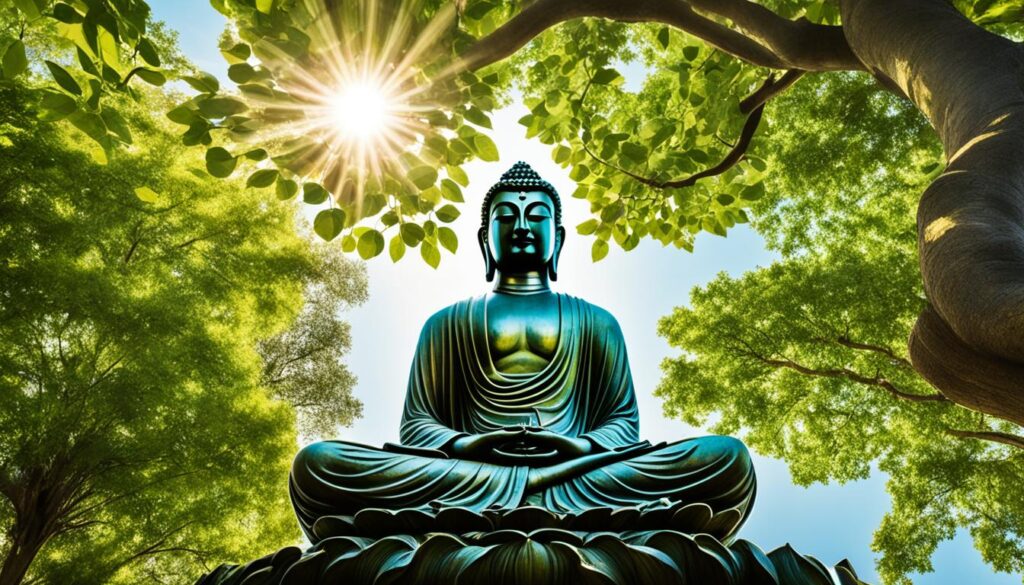“Do not dwell in the past, do not dream of the future, concentrate the mind on the present moment.” – Buddha
How old is Buddhism? What are its origins? Who was its founder? These questions echo through time, inviting us to uncover the profound spiritual journey that is Buddhism. With a history spanning over 2,500 years, Buddhism has touched the lives of countless individuals seeking enlightenment and inner transformation. Rooted in ancient India and founded by Siddhartha Gautama, who would become known as the Buddha, Buddhism offers a timeless philosophy that continues to inspire and guide people today.
Key Takeaways:
- Buddhism is a spiritual journey that dates back over 2,500 years.
- Siddhartha Gautama, later known as the Buddha, founded Buddhism in ancient India.
- Buddhism emphasizes understanding the nature of suffering, its causes, and the path to liberation.
- The Four Noble Truths and the Eightfold Path provide a transformative journey toward enlightenment.
- Buddhism’s teachings focus on mindfulness, compassion, and ethical living for personal and societal harmony.
The Life of Siddhartha Gautama: From Prince to Buddha
Siddhartha Gautama, born into a royal family in the 6th century BCE, embarked on a remarkable journey from a life of material wealth and privilege to the path of spiritual enlightenment. Seeking answers to the profound questions of human existence, Siddhartha renounced his princely status and set out on a quest for truth and liberation from suffering.
Determined to discover the nature of reality and the causes of human suffering, Siddhartha embraced a life of rigorous asceticism. Through self-discipline and practices of extreme deprivation, he sought to transcend the limitations of the human experience.
However, after years of enduring physical hardships and self-mortification, Siddhartha realized that asceticism alone would not lead him to the truth he sought. He recognized that neither extreme indulgence nor severe self-denial would bring about the liberation he yearned for.
It was at this critical juncture that Siddhartha made a momentous decision. He abandoned the path of asceticism and turned to deep meditation as the means to uncover the ultimate reality. Under the shade of the Bodhi tree, Siddhartha engaged in profound contemplation, delving into the depths of his own consciousness.
After an intense period of meditation, Siddhartha achieved enlightenment and awakened to the reality of existence. He emerged from his meditative state as the Buddha, meaning “the awakened one.” With newfound clarity and insight, the Buddha formulated his teachings, which would become the foundation of Buddhism.
The philosophy of the Buddha centers around the understanding that suffering arises from desire and attachment. He emphasized that liberation from suffering can be attained by relinquishing these desires and attachments. The Buddha’s teachings also encompassed ethical principles, meditation, mindfulness, and concentration as essential practices for attaining liberation.
Through his profound understanding of the human condition and his teachings on desire, suffering, and liberation, the Buddha offered a transformative path to his followers. His teachings continue to inspire and guide millions of people around the world who seek inner peace and freedom from the cycle of suffering.
Next, we will explore the spread and evolution of Buddhism as it journeyed from its origins in ancient India to various regions and cultures across the globe.

Spread and Evolution of Buddhism: From India to the World
Buddhism, originating in the Ganges Basin of ancient India, quickly spread across the Indian subcontinent and beyond, gaining a universal appeal. As it journeyed through different regions and cultures, Buddhism adapted and evolved, giving rise to diverse traditions that continue to thrive today.
Buddhism’s Spread Across Diverse Cultures
The spread of Buddhism led to the emergence of distinct traditions such as Theravada, Mahayana, and Zen. Each tradition reflects the cultural and philosophical influences of the regions it encountered, creating a tapestry of diverse practices and beliefs.
Theravada Buddhism, prevalent in Sri Lanka and Southeast Asia, adheres closely to the original teachings of the Buddha and emphasizes individual liberation through meditation and ethical living.
- Mahayana Buddhism, prominent in East Asia, places greater emphasis on compassion and the liberation of all sentient beings. It encompasses traditions such as Pure Land and Zen Buddhism.
- Zen Buddhism, known for its minimalist aesthetics and emphasis on direct experience, emerged in China and later spread to Japan.
The cultural adaptation of Buddhism allowed it to transcend geographical and societal boundaries, resonating with people from diverse backgrounds. Its universal appeal lies in its emphasis on practices such as mindfulness, meditation, and compassion, which offer individuals a path to inner transformation and a harmonious way of life.
To illustrate this diversity, here is a table showcasing the key characteristics of Theravada, Mahayana, and Zen Buddhism:
| Tradition | Key Characteristics |
|---|---|
| Theravada | Focus on original teachings of the Buddha, individual liberation, meditation, ethical living |
| Mahayana | Emphasis on compassion, liberation of all sentient beings, Pure Land and Zen Buddhism |
| Zen | Minimalist aesthetics, direct experience, mindfulness, meditation |

As Buddhism spread across Asia and even reached Europe in later centuries, it continued to adapt and assimilate various cultural practices, further enriching its diverse tapestry of traditions. Today, Buddhism’s reach extends far beyond its origins in ancient India, inspiring millions worldwide to embark on a spiritual journey of mindfulness, compassion, and ethical living.
The Essence of Buddhism: A Path to Inner Transformation
At the heart of Buddhism lies the pursuit of inner transformation and awakening. Unlike many religions that focus on external deities, Buddhism centers on your journey toward understanding, compassion, and self-awareness.
Through practices like mindfulness and meditation, Buddhism guides you in cultivating a clear and compassionate mindset, leading to personal and spiritual growth. By delving deeper into your own mind and embracing the principles of Buddhism, you can experience inner peace, wisdom, and the freedom from suffering.
The Power of Mindfulness
Mindfulness is a fundamental practice in Buddhism, focusing your attention on the present moment with an open and non-judgmental attitude. By practicing mindfulness, you become more aware of your thoughts, emotions, and sensations, allowing you to break free from automatic patterns of reactivity.
Cultivating Compassion
Compassion is another core principle of Buddhism. It involves developing a genuine concern for the welfare of others and extending kindness and understanding to all beings. Through cultivating compassion, you foster a sense of connection and empathy, promoting harmony and unity.
Buddhism teaches that self-awareness is vital for personal growth. By observing your thoughts, emotions, and actions without judgment, you gain insight into the true nature of your mind. This self-awareness allows you to identify and transform negative patterns, promoting positive change and personal development.
In Buddhism, harmony is not only sought within oneself, but also in relation to others and the world. By embracing compassion, self-awareness, and mindfulness, you can cultivate harmony within your relationships, communities, and the environment, fostering a sense of interconnectedness and cooperation.

The ultimate goal of Buddhism is enlightenment, a state of profound spiritual awakening and liberation from suffering. The path to enlightenment involves deepening your understanding of reality, letting go of attachments, and cultivating wisdom and compassion.
Buddhism provides a framework for personal spiritual development, offering practical tools and practices to support your journey. By integrating the teachings of Buddhism into your life, you can experience inner transformation, find harmony within yourself and the world, and embark on a path of self-discovery and enlightenment.
The Historical Origins of Buddhism: Siddhartha Gautama’s Revolutionary Path
Buddhism traces its roots back to ancient India, a diverse religious landscape during the Axial Age. This period witnessed a rising wave of critical thinking and questioning of traditional religious practices, paving the way for Siddhartha Gautama’s transformative journey to enlightenment.
Siddhartha Gautama, born into a privileged royal family, embarked on a path of renunciation, abandoning his luxurious life in search of deeper truths. He dedicated himself to rigorous ascetic practices, aiming to overcome the cycle of suffering that plagued humanity.
However, Siddhartha soon realized that extreme self-mortification was not the path to liberation. It was during his profound meditation under the Bodhi tree in Bodh Gaya that he attained enlightenment, becoming the Buddha, the Awakened One.
The Buddha’s teachings emphasized the Middle Way, a philosophy of moderation between self-indulgence and self-mortification. This path advocated for a balanced approach to life, rejecting extremes and embracing a harmonious existence.
Through his profound insights, the Buddha outlined the practical and transformative teachings that continue to guide millions to this day. His emphasis on mindfulness, compassion, ethical conduct, and the pursuit of enlightenment resonates with individuals striving for spiritual growth and liberation from suffering.
| Key Concepts | Description |
|---|---|
| Renunciation | Siddhartha Gautama’s decision to leave behind his luxurious life as a prince in search of answers. |
| Ascetic Practices | Siddhartha’s rigorous self-denial and extreme disciplines in his pursuit of enlightenment. |
| Bodh Gaya | The sacred site where Siddhartha achieved enlightenment through deep meditation. |
| Enlightenment | The state of profound wisdom and liberation from the cycle of suffering. |
| Middle Way | The balanced path advocated by the Buddha, avoiding extremes and embracing moderation. |
The historical origins of Buddhism marked a revolutionary shift in spiritual thought, challenging the prevailing religious and societal norms of ancient India. Today, the teachings of the Buddha continue to inspire individuals around the world on their own paths to enlightenment and self-discovery.
The Four Noble Truths: A Roadmap to Liberation
The Four Noble Truths form the foundation of Buddhism, offering a transformative path towards understanding and overcoming suffering. These profound truths serve as a guiding light, leading individuals on a journey towards enlightenment and liberation.
Understanding the Nature of Suffering
The first noble truth is the acknowledgement of suffering and its pervasive existence in our lives. Suffering manifests in various forms, encompassing physical pain, emotional turmoil, and the dissatisfaction that permeates our daily experiences.
Recognizing the nature of suffering is the first step towards liberation, providing clarity and insight into the challenges that life presents.
Exploring the Causes of Suffering
The second noble truth delves into the root causes of suffering: desires and attachments. Buddhism teaches that our cravings and attachments to transient pleasures and material possessions lead to suffering and dissatisfaction. These desires create a constant cycle of longing and dissatisfaction, preventing true contentment and inner peace.
By understanding the causes of suffering, we can begin to release our attachments and find freedom from their grasp.
Achieving the Cessation of Suffering
The third noble truth offers hope and possibility by revealing that the cessation of suffering is attainable. By relinquishing desires and attachments, we can break free from the chains that bind us and experience a state of liberation.
Through the cessation of suffering, we discover profound inner peace, contentment, and an unwavering sense of well-being.
The Eightfold Path: Cultivating Enlightenment and Liberation
The fourth noble truth presents the Eightfold Path, a comprehensive set of principles and practices that lead to liberation from suffering. This path encompasses eight interconnected aspects that guide individuals on their transformative journey:
- Right Understanding
- Right Intention
- Right Speech
- Right Action
- Right Livelihood
- Right Effort
- Right Mindfulness
- Right Concentration
Each aspect of the Eightfold Path plays a vital role in cultivating wisdom, ethical conduct, and mental discipline. By following this path, we develop the necessary qualities to attain enlightenment and experience liberation from suffering.
Embracing the Four Noble Truths and integrating the Eightfold Path into our lives provides a roadmap to liberation, leading us towards enlightenment, inner transformation, and the ultimate attainment of true peace and liberation.

The Enduring Legacy of the Buddha: Inspiring Millions
Although the physical life of the Buddha ended with his Parinirvana, his teachings continue to inspire and guide millions of people worldwide. The Buddha’s legacy lies not in being worshipped as a deity, but in being revered as an extraordinary human who discovered a path to enlightenment and liberation from suffering. His teachings provide timeless wisdom and practical guidance for individuals seeking inner peace, spiritual growth, and a deeper understanding of their existence. Buddhism’s universal appeal stems from its emphasis on personal transformation, ethical living, and the pursuit of wisdom. The legacy of the Buddha transcends time and culture, offering a living philosophy that continues to resonate with seekers around the world.
Buddha’s Legacy: Teachings that Inspire
The teachings of the Buddha form the foundation of Buddhism and carry profound significance for those who yearn for spiritual growth and understanding. Buddha’s teachings revolve around the concept of suffering and the ultimate liberation from it, offering a roadmap to enlightenment and inner peace.
- Understanding the Nature of Suffering: The Buddha’s teachings shed light on the inherent dissatisfaction and suffering that permeate human existence. By recognizing the impermanence of material possessions and the transient nature of life, individuals can cultivate a deeper understanding of suffering and its causes.
- The Path to Liberation: Buddhism provides practical guidance through the Four Noble Truths and the Eightfold Path. These teachings offer a holistic framework for personal transformation, guiding individuals towards the cessation of suffering and the attainment of liberation.
- Cultivating Universal Wisdom: The wisdom of the Buddha’s teachings extends beyond cultural and religious boundaries, resonating with individuals from diverse backgrounds. Buddhism’s emphasis on mindfulness, compassion, and ethical living appeals to the universal human desire for personal growth and harmony.
The enduring appeal of Buddhism lies in its ability to provide timeless guidance and wisdom that is applicable to individuals in any era. Whether it is navigating the complexities of modern life or seeking personal and spiritual growth, the teachings of the Buddha offer profound insights and transformative practices. The legacy of the Buddha continues to inspire millions, serving as a beacon of hope and enlightenment in the journey towards understanding existence and achieving inner peace.
| Key Aspects | Benefits |
|---|---|
| Personal Transformation | Guides individuals towards self-discovery and spiritual growth |
| Ethical Living | Promotes compassion, mindfulness, and a harmonious relationship with oneself and others |
| Pursuit of Wisdom | Provides profound insights and practical guidance for understanding the nature of existence |
The enduring legacy of the Buddha continues to inspire and resonate with people all over the world. Buddhism’s appeal lies in its ability to offer a timeless philosophy that addresses the deep-rooted human desire for spiritual growth, inner peace, and understanding. As individuals embrace the teachings of the Buddha, they embark on a transformative journey of self-reflection, compassion, and enlightenment.
Conclusion
Embarking on a spiritual journey is a powerful and transformative experience. Buddhism, with its ancient roots and profound teachings, offers a path towards enlightenment and personal growth. The wisdom of Buddhism, gained through an understanding of suffering and the pursuit of liberation, provides invaluable insights that can guide us through the challenges of modern life.
Through mindfulness and compassion, Buddhism teaches us to cultivate inner peace and well-being. By living ethically and embracing the principles of Buddhism, we can create harmony within ourselves and in society. The age-old wisdom of Buddhism offers a framework for personal development and a roadmap for societal harmony.
As you delve into the teachings of Buddhism, you embark on a journey of self-discovery, awakening, and the realization of inner peace and harmony. The profound wisdom of Buddhism beckons you to explore the depths of your being, shedding light on the true nature of existence and guiding you towards enlightenment. Embrace the transformative power of Buddhism and embark on a spiritual journey that will lead you to wisdom, personal growth, and the realization of a harmonious life.
FAQ
How old is Buddhism?
Buddhism dates back over 2,500 years, making it one of the oldest religions in the world.
Who founded Buddhism?
Buddhism was founded by Siddhartha Gautama, who later became known as the Buddha.
What is the history of Buddhism?
Buddhism originated in ancient India during a period known as the Axial Age, which was marked by the rise of critical thinking and questioning of traditional religious practices.
What are the origins of Buddhism?
Buddhism originated in the Ganges Basin of ancient India.
How did Buddhism spread and evolve?
Buddhism quickly spread across the Indian subcontinent and beyond, adapting and evolving as it journeyed through different cultures and giving rise to diverse traditions such as Theravada, Mahayana, and Zen.
What is the essence of Buddhism?
Buddhism emphasizes personal transformation, mindfulness, compassion, self-awareness, and harmony.
Who was Siddhartha Gautama?
Siddhartha Gautama was the founder of Buddhism who renounced his privileged life to seek answers to the fundamental questions of human existence.
What are the Four Noble Truths?
The Four Noble Truths are the foundational teachings of Buddhism, offering a roadmap for understanding and overcoming suffering.
What is the legacy of the Buddha?
The Buddha’s teachings continue to inspire and guide millions of people worldwide, offering valuable insights for personal growth, inner peace, and a deeper understanding of existence.
How does Buddhism contribute to personal and societal harmony?
Buddhism promotes mindfulness, compassion, ethical living, and the pursuit of wisdom, which fosters personal well-being and creates harmony in society.

